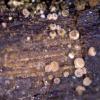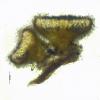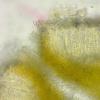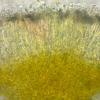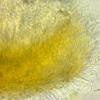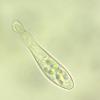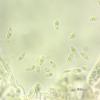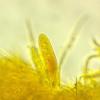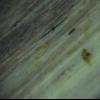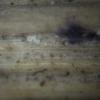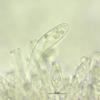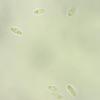
02-01-2026 17:43
MARICEL PATINOHi there, although I couldn't see the fruitbody, I

01-01-2026 18:35
Original loamy soil aside a artificial lake.The co

31-12-2025 19:27
Collected from loamy soil, at waterside (completel

30-12-2025 16:44
Pascal DucosBonjour,Une anamorphe rose stipitée, très nombre

30-12-2025 17:14
 Bernard CLESSE
Bernard CLESSE
Bonjour à toutes et tous,Pourriez-vous aider Albe
Unguiculariopsis
Elisabeth Stöckli,
11-03-2019 14:02
Bonjour,
Récolté sur branche morte de lierre (Hedera/jardin/385m), apothécies 0.1-0.3mm de diamètre, surface externe couverte de petits poils en crochet, renflés à la base, hyménium beige, asques 28-44 x 7-9 µm, crochets+, IKI-, octosporés, spores ellipsoïdes 6.5-8 x 2.5-3 µm, lisses, hyalines, contenant quelques gouttes, les poils ne se dissolvent pas dans 3 % KOH.
Merci d'avance pour vos avis.
Elisabeth
Stip Helleman,
11-03-2019 19:06

Re : Unguiculariopsis
Hi Elisabeth,
may I suggest Hyalacrotus, close to pseudopani.
Amitiés,
Stip
Kosonen Timo,
12-03-2019 10:14

Re : Unguiculariopsis
Hi,
Macroscopically it resembles Unguiculella eurotioides to me, and maybe the measurements fit. But just an idea. Any chanche of getting a paraphyse / a whole hair in focus in a thin slide? Are the paraphyses also solidified - I can't say.
Timo
Stip Helleman,
12-03-2019 22:49

Re : Unguiculariopsis
Hi,
I don't know U. eurotioides from my own experience but this golden-yellow intercellular substance seems to be in my present knowledge a feature of Hyalocrotus which has more species that are closer related to Unguiculariopsis.
I don't know U. eurotioides from my own experience but this golden-yellow intercellular substance seems to be in my present knowledge a feature of Hyalocrotus which has more species that are closer related to Unguiculariopsis.
cheers,
Stip
Hans-Otto Baral,
13-03-2019 09:41

Re : Unguiculariopsis
Indeed, I first thought Unguiculariopsis, but Timo is right when comparing Unguiculella eurotioides. I saw this species frequently, but cannot tell if it was always the same. Especially the spore contents vary, maybe by external influence. Spores with such large drops are figured in my drawing Unguiculella eurotioides cf., HB 6570, 6877.JPG.
And indeed, also Stip is right when comparing Hyalacrotes pseudopani, which I put in my eurotioides folder as a possible synonym.
There is an urgent need to obtain sequences of Unguiculella/Hyalacrotes. My guess is that they belong like Unguiculariopsis in Cordieritidaceae.
Zotto
And indeed, also Stip is right when comparing Hyalacrotes pseudopani, which I put in my eurotioides folder as a possible synonym.
There is an urgent need to obtain sequences of Unguiculella/Hyalacrotes. My guess is that they belong like Unguiculariopsis in Cordieritidaceae.
Zotto
Stip Helleman,
14-03-2019 18:56

Re : Unguiculariopsis
@ Zotto, yes you might be right these two species are identical.This species is in the Cordieritidaceae in my phylogenetic result from Januari, I thought that I did send you mein Ergebnisse.
@ Elisabeth, I will be happy to work with this collection too, it looks like if there are enough fruitbodies for DNA extraction.
@ Elisabeth, I will be happy to work with this collection too, it looks like if there are enough fruitbodies for DNA extraction.
cheers,
Stip
Hans-Otto Baral,
14-03-2019 21:44

Re : Unguiculariopsis
Hoi Stip
ich finde deinen Baum nicht (der letzte ist von Juni 2018) und auch keine Mail. Aber ich habe eine Sequenz von Francois Valade von einer Unguiculella mit langen fadenförmigen Sporen, die in die Cordieritidaceae fällt. Ich war nicht sicher, ob es ein Helicogonium ist, und das ist auch nicht ganz ausgeschlossen, falls die Sequenz nur für die sterilen Elemente gilt. Aber es wäre gut, die mit deiner zu vergleichen, wie groß die Ähnlichkeit ist. Es ist ITS und LSU.
Zotto
ich finde deinen Baum nicht (der letzte ist von Juni 2018) und auch keine Mail. Aber ich habe eine Sequenz von Francois Valade von einer Unguiculella mit langen fadenförmigen Sporen, die in die Cordieritidaceae fällt. Ich war nicht sicher, ob es ein Helicogonium ist, und das ist auch nicht ganz ausgeschlossen, falls die Sequenz nur für die sterilen Elemente gilt. Aber es wäre gut, die mit deiner zu vergleichen, wie groß die Ähnlichkeit ist. Es ist ITS und LSU.
Zotto
Stip Helleman,
14-03-2019 22:04

Re : Unguiculariopsis
Ich schicke dich den Baum privat,
Stip
Stip Helleman,
16-03-2019 00:15

Re : Unguiculariopsis
This eurotioides/ pseudopani thingis stil dazzling me, it seems to be evidential that these two names are used for the same species. On the other hand there is a U. eurotioides on herbaceous stems in the low lands of France and the Netherlands that represents a different species, although the ascal and spore mesurements are alike this is a far more delicate species as the comparable fleshy pseudopani.
cheers,
Stip
Hans-Otto Baral,
16-03-2019 08:16

Re : Unguiculariopsis
This is an interesting idea, Stip.
Also the synonymous Dasyscypha campylotrichia on thistle (Carduus/Cirsium?) was described with very tiny apothecia (0.15-0.2 mm, spores 5 / 2), like eurotioides (0.2 mm, on Artemisia vulgaris and Anthriscus sylvestris, spores 5-8 / 2-2.5).
Urceolella pseudopani on indet. wood was described only with 0.3 mm diam. (spores 6-7.5 / 2-3).
So you think this is difference enough?
And what when it grows on Rubus fruticosus?
In my folder I have various samples which partly do not support the idea. E.g., 19.IX.2017 on Epilobium: 0.2-0.45 mm. - 21.I.2019 on Cytisus: 0.1-0.2 mm. - HB 8053 on Fagus: 0.08-0.13 mm. - But: HB 7786b on ?Fraxinus: 0.4-0.8 mm.
Raitviirs statement of amyloid asci in eurotioides is weird. Is it simply an error? I never saw an amyloid reaction in this group.
Zotto
Also the synonymous Dasyscypha campylotrichia on thistle (Carduus/Cirsium?) was described with very tiny apothecia (0.15-0.2 mm, spores 5 / 2), like eurotioides (0.2 mm, on Artemisia vulgaris and Anthriscus sylvestris, spores 5-8 / 2-2.5).
Urceolella pseudopani on indet. wood was described only with 0.3 mm diam. (spores 6-7.5 / 2-3).
So you think this is difference enough?
And what when it grows on Rubus fruticosus?
In my folder I have various samples which partly do not support the idea. E.g., 19.IX.2017 on Epilobium: 0.2-0.45 mm. - 21.I.2019 on Cytisus: 0.1-0.2 mm. - HB 8053 on Fagus: 0.08-0.13 mm. - But: HB 7786b on ?Fraxinus: 0.4-0.8 mm.
Raitviirs statement of amyloid asci in eurotioides is weird. Is it simply an error? I never saw an amyloid reaction in this group.
Zotto
Stip Helleman,
16-03-2019 23:55

Re : Unguiculariopsis
The amyloid ascus is an error from , also for this lowland species.
the most destinctive feature besides the consistence of the fruitbodies lies in the excipular intercellular yellow gel for pseudopani I think. There is too much overlap in measurements, I attach 2 macro-photos from the 2 lowlandcollections. They were 0,1 mm
the most destinctive feature besides the consistence of the fruitbodies lies in the excipular intercellular yellow gel for pseudopani I think. There is too much overlap in measurements, I attach 2 macro-photos from the 2 lowlandcollections. They were 0,1 mm
Stip
Hans-Otto Baral,
17-03-2019 07:54

Re : Unguiculariopsis
Do you think the lowland species occurs only in F and NL? :-))
The yellow exudate may be a good character. It can also be brownish (see HB 7641b).
But data on the excipular colour in samples on herbs are rare in my folder, and from apothecial colour it is not clear at all.
Will be time to gain a sequence of your lowland forms.
Zotto
The yellow exudate may be a good character. It can also be brownish (see HB 7641b).
But data on the excipular colour in samples on herbs are rare in my folder, and from apothecial colour it is not clear at all.
Will be time to gain a sequence of your lowland forms.
Zotto
Elisabeth Stöckli,
17-03-2019 17:27
Kosonen Timo,
18-03-2019 07:32

Re : Unguiculariopsis
Thanks Elisabeth for the photos,
I have some recent collections from U. eurotioides from Sweden/Finland. No cultures, just the apos. Should be able to get some seqs also; luckily these are not the smallest of smallest. Also what I know of, this "unguiculella" doesn't belong to the traditional "Hyaloscyphaceae" clades.
bw
Timo




